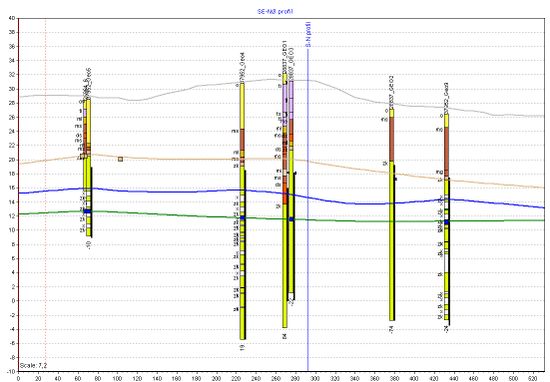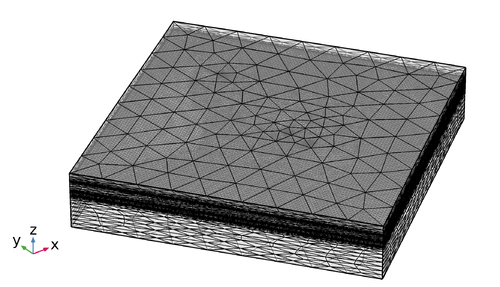Difference between revisions of "Model setup"
m (→Steps to setup a model for flow and transport in fractured limestone aquifers: Reordered list) |
m (→Mesh generation) |
||
| (3 intermediate revisions by the same user not shown) | |||
| Line 96: | Line 96: | ||
=== Choice of boundary conditions and sources/sinks === | === Choice of boundary conditions and sources/sinks === | ||
<div class="mw-collapsible-content"> | <div class="mw-collapsible-content"> | ||
| − | Boundary conditions | + | Boundary conditions should be chosen according to known or delineated boundaries, such as geologic boundaries, known hydraulic head isolines, known flowlines (can be used as no-flow condition perpendicular to them, if the flow field is stable). |
The most common boundary conditions are | The most common boundary conditions are | ||
| − | * Dirichlet conditions (or first-type boundary conditions), where the primary variable is fixed to a value (e.g. fixed head or fixed concentration). | + | * Dirichlet conditions (or first-type boundary conditions), where the primary variable is fixed to a value (e.g. fixed hydraulic head or fixed concentration). |
* Neumann conditions (or second-type boundary conditions), where the gradient of the primary variable is specified (e.g. flux across the boundary, often no-flow boundaries) | * Neumann conditions (or second-type boundary conditions), where the gradient of the primary variable is specified (e.g. flux across the boundary, often no-flow boundaries) | ||
| − | * Cauchy conditions (or third-type boundary conditions), which sets a condition to the primary variable and | + | * Cauchy conditions (or third-type boundary conditions), which sets a condition to the primary variable and its derivative (used f.e. for the infiltration flux through a river bed). |
| − | The | + | The proper choice of boundary conditions is a very important step and determines the calculated results. |
| − | |||
| − | Sources and sinks | + | Sources and sinks can be added in the model domain to include e.g. withdrawal/injection at wells or groundwater recharge due to precipitation. |
</div> | </div> | ||
</div> | </div> | ||
<div class="collapsiblebar mw-collapsible mw-collapsed"> | <div class="collapsiblebar mw-collapsible mw-collapsed"> | ||
| + | |||
=== For transient models: definition of initial conditions === | === For transient models: definition of initial conditions === | ||
<div class="mw-collapsible-content"> | <div class="mw-collapsible-content"> | ||
Steady-state models do not require the definition of initial conditions. | Steady-state models do not require the definition of initial conditions. | ||
| − | Transient problems, however, require to specify the initial value of the primary variables at each location of the model domain. | + | Transient problems, however, require to specify the initial value of the primary variables (e.g. concentrations at each location of the model domain. |
</div> | </div> | ||
</div> | </div> | ||
| Line 121: | Line 121: | ||
<div class="mw-collapsible-content"> | <div class="mw-collapsible-content"> | ||
[[File:MeshExample.png |thumb|right|500px|Example a mesh used for discrete-fracture simulations of the Akacievej tracer tests. The mesh is refined at the horizontal fractures and at the wells.]] | [[File:MeshExample.png |thumb|right|500px|Example a mesh used for discrete-fracture simulations of the Akacievej tracer tests. The mesh is refined at the horizontal fractures and at the wells.]] | ||
| − | When working with complex models it is useful to start with a coarse mesh to test the model and the setup with limited | + | When working with complex models it is useful to start with a coarse mesh to test the model and the setup with limited computational efforts. |
| − | When | + | When the model is properly setup, a finer grid can be employed. |
| − | Modern grid generators allow a local mesh refinement at specific parts of the mesh. | + | Modern grid generators allow a local mesh refinement at specific locations in the model domain. |
| + | Locations, where strong gradients of the primary variables (head, concentration) occur, should be resolved at a high resolution, while for the parts of the model domain with only small changes, a coarser mesh resolution may be sufficient. | ||
Especially at heterogeneities and fractures, at wells and at concentration fronts, the mesh should be sufficiently fine to resolve the local gradients (e.g. of concentration or head gradients) appropriately. | Especially at heterogeneities and fractures, at wells and at concentration fronts, the mesh should be sufficiently fine to resolve the local gradients (e.g. of concentration or head gradients) appropriately. | ||
| − | |||
| − | If the applied mesh is sufficiently fine can be tested by a grid refinement study, where the mesh is gradually refined and the results are compared. | + | |
| − | When the | + | If the applied mesh is sufficiently fine can be tested by a grid refinement study, where the mesh is gradually refined and the model results are compared. |
| + | When the results do not significantly change with a further grid refinement, the grid resolution is sufficient. | ||
<br clear=all> | <br clear=all> | ||
</div> | </div> | ||
Latest revision as of 12:07, 3 July 2019
| Highlights |
|---|
|
Contents
Steps to setup a model for flow and transport in fractured limestone aquifersThis chapter gives an overview of the recommended steps to setup a model for the simulation of flow and transport in a fractured limestone aquifer. The following list shows the typical steps to setup a model for contaminant transport in a fractured limestone aquifer. Expand an item (button on the right) to get more information about it. Example: Setup of a COMSOL Multiphysics model for a contaminated site with a fractured limestone aquifer (Akacievej, Hedehusene)The setup of a discrete-fracture model in 2D in COMSOL Multiphysics using Coefficient Form PDEs is described in the following document: COMSOL provides also the possibility to include fracture flow in the Darcy's Law interface, while fracture transport can be included in the Transport of Diluted Species in Porous Media interface. We refer to the product documentation for more details. FEFlow provides a tutorial, that describes the steps of setting up a flow and transport model and how to include discrete fractures. DRAFT: The typical workflow for modeling a contaminated site will be demonstrated using an example field site close to Copenhagen. Example: Setup of models for a field site (Akacievej, Hedehusene) |

